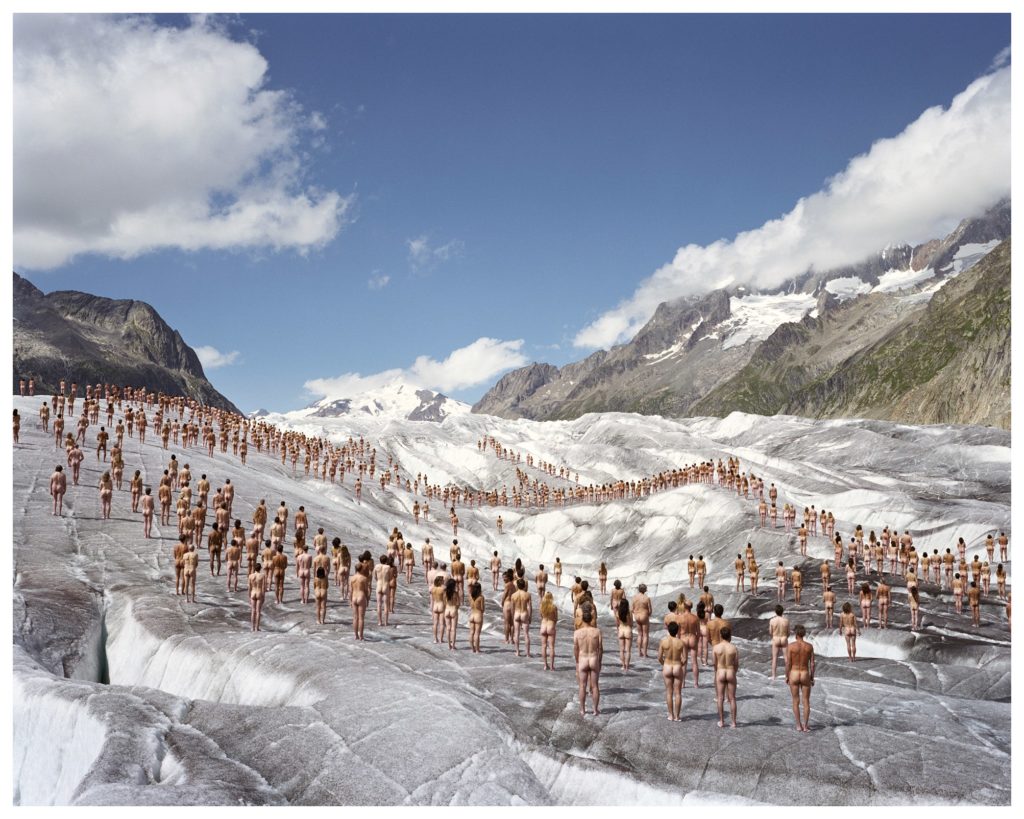American photographer Spencer Tunick (b. 1967) is known for his spectacular and colossal nude photography. In urban settings or natural landscapes, his human plants a fascinating new entity. "Sometimes I recognise the same faces on set. "
Text: Kirstin Hanssen Photography: Spencer Tunick
In 2007, 2,000 volunteers in Amsterdam's Europarking take off their clothes and assume the position instructed to them by Spencer Tunick just before. They stand on chairs and paint with a colour palette full of skin tones into the normally open vista of the striking building. Those who want to figure in "a Spencer Tunick" must get up early, because when the sun rises, the artist wants to have captured what he calls "the body without clothes" and "the body in multiples". "That is when the light is at its most beautiful and the city is still silent.
I am very grateful for the people who are always willing to become part of my art," says the artist, who is back in the Netherlands for his solo exhibition 'Public Interventions' at Reflex Amsterdam gallery. According to Tunick, while photographing, an interesting group dynamic, an experiment as it were, usually involves forming three to four set-ups. In the 1990s, he staged his first photographs of naked bodies in urban landscapes in his hometown of New York.
Initially, these were individual nude portraits in public spaces. Models he found in bars, restaurants and via via. "At one point, I had a list of about 50 people. It would take at least three years to capture them. I am a people pleaser, didn't want to disappoint anyone. 'What if I photograph everyone at once?' And so it happened in 1994."
 Exposure to art
Exposure to art
Spencer Tunick grew up in a creative nest. "My mother worked in the world of art and interior design. My father was a commercial photographer. At a young age, I learnt to look at objects in museum settings. The first painting I remember seeing was Henri Rousseau's 'The Dream' at MoMA. That shows a naked woman in the jungle. But there have been more influences. Claes Oldenburg's installations, 'Fallingwater' by architect Frank Lloyd Wright."
After art school, Tunick went to work as a photographer himself and was soon part of the New York-based art scene. After the first group session with 50 nudes takes place, Tunick wants to capture more people. "When bodies are grouped together, they begin to lose their individuality and become a kind of substance. Very fascinating. I wanted to explore that further. At the same time, I met my wife Kristin Bowler.
She is a graphic designer and offered to design a flyer I could use to recruit models. 1,000 flyers distributed yielded a turnout of 100 people. I was so surprised by it." These days, Tunick no longer has to do flyers. People sign up en masse to be captured after calls. Culminating in 18,000 nudes in Mexico City's iconic Zócalo Square in 2007. "Sometimes I recognise the same faces on set. I then ask those not to take the front seat."
 Hotel slippers
Hotel slippers
No matter how many bare breasts, buttocks and penises are on display, Tunick's work is anything but erotic. For him, nudity is a kind of prop. With his work, he creates a surreal world where the body reflects nature or, conversely, the city, as when he had hundreds of people pose on a Swiss glacier. "A commission for Greenpeace to draw attention to climate change and also probably my most challenging project. Because although it was not necessarily cold on the glacier because of the sun, anyone standing barefoot on the ice runs the risk of hypothermia or slipping. That's why everyone stood on hotel slippers, barely visible from a distance."
The tension between nature and city is also visible in 'Sea of Hull', where hundreds of painted, blue bodies transform an anonymous street into an abstract body of water passing through the British city. The traffic lights present in the street add an extra twist to the scene. "I definitely leave such elements in the image. I capture what is there. I am also not an image editor or techie. For twenty years I shot analogue. Then Fujifilm stopped producing the films I always used.
One of my biggest artistic disappointments as I had to switch to digital. I removed almost all the buttons on my new camera, all I can adjust is the shutter, iso and aperture." He laughs: "Yes, it increases the pressure to perform within the limited time even more!"
 Social engagement
Social engagement
Whereas previously it was only naked bodies whether bodypainted or not, in his current work Spencer Tunick also uses props, such as the fairy-like veils with which models pose as if they were ghosts in the Nevada desert or the sun lamps that symbolise the sun as a source of energy in 'Bodø Bodyscape'. "Social themes are important to me. Climate, but also lhtbq+ topics and in the past HIV."
Social commitment Tunick also showed with his Instagram project 'Stay Apart Together' that brought friends, family members and loved ones together digitally in the era of Covid-19 by working from home through video conferencing pose simultaneously. About his future plans, he says: "I would like to photograph in Armenia, as Kristin has Armenian roots. But 'The Big Island' of Hawaii is also on my wish list, although I still haven't managed to get a licence there.
I expect to continue for another 10 years, maybe I will stop travelling after that. We are now out of the pandemic. People can come closer together again and have hope that the future will be brighter. That is what I am focusing on."
Spencer Tunick is represented in the Netherlands by Reflex Amsterdam.
reflexamsterdam.com
spencertunick.com
 SPENCER TUNICK
SPENCER TUNICK
Favourite artist: Yayoi Kusama
Best place on earth: Mexico
Means of transport: foldable bike and Toyota Hybrid
Watch: none
Camera: Fujifilm GFX System



